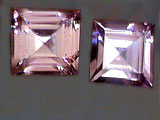![]()
Name:
Spinel

Chem:
MgAl2O4
-
Magnesium Aluminum Oxide
Crystal:
Isometric (usually in octahedrons or cubes)
Color:
color: pink, violet, red, yellow, orange, blue, green, black, brown
Refrac. Index:
1.71 - 1.74
Birefraction:
None
Hardness:
8.0
Spec. Grav.:
3.58 - 3.61
Fracture:
conchoidal
Cleavage:
imperfect
Environment:
found mainly in metamorphics rocks
Association:
olivine, hornblende, phlogopite, chondrodite
Locals:
| Ceylon | Burma | Canada | N.Y., N.J., Calif., USA | Brazil | Pakistan | Sweden |
Misc:
The origin of the name is uncertain but probably comes from the Latin "spina", meaning "thorn", in reference to sharply pointed crystals. It is an excellent refractory material and has been used in many high-temperature applications. It has been synthesized since 1910 and is now available in more synthetic colors than natural colors.
Gem info:
Good quality red spinel is difficult to tell from ruby, and for years a large red-stone in the British Crown Jewels was identified as the Black Prince's Ruby", but was eventually discovered to be a red spinel.
Several colors have trade names, purple spinel is called "almandine spinel", very dark blue-green stones are called "pleonast", and orange-pink spinel is called "rubicelle". Although none of these are common names, they may be refereed to in some cultures.
Good red spinels and good blue spinels command prices near the top of the secondary market, but are not anywhere near on par with their ruby and sapphire counter parts. Pink spinels, and other pale colors have far less value.
![]()
2 stones
![]()
pink w/ inclusion
![]()
violet spinel